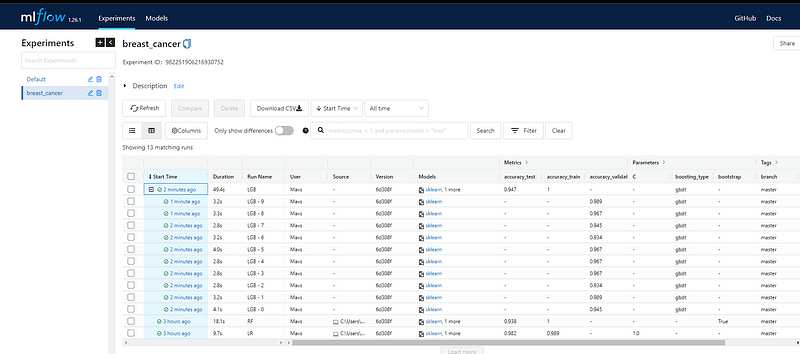Logging & Tracking
Logging
To start logging your experiments, fill the logger
parameter with the name or path to store the logging file. If automatic
naming is used, the file is saved using the __name__ of the class
followed by the timestamp of the logger's creation, e.g.
ATOMClassifier_11May21_20h11m03s. The logging file contains method
calls, all printed messages to stdout with maximum verbosity, and any
exception raised during running. Additionally, the logging entries of
external libraries are redirected to the same file handler.
Tracking
ATOM uses MLflow Tracking
as a backend API and UI for logging models, parameters, pipelines, data
and plots. Start tracking your experiments assigning a name to the
experiment parameter. Every model is
tracked using a separate run. When no backend is configured, the data is
stored locally at ./mlruns. To configure the backend, use
mlflow.set_tracking_uri
in your notebook or IDE before initializing atom. This does not affect
the currently active run (if one exists), but takes effect for successive
runs. Run mlflow ui on your terminal to open MLflow's Tracking UI and
view it at http://localhost:5000.
Note
When using ATOM on Databricks, the
experiment's name should include the complete path to the storage,
e.g., /Users/username@domain.com/experiment_name.
Example
from atom import ATOMClassifier
from sklearn.datasets import load_breast_cancer
X, y = load_breast_cancer(return_X_y=True, as_frame=True)
atom = ATOMClassifier(X, y, experiment="breast_cancer")
atom.run(models=["LR", "RF", "LGB"], n_trials=(0, 0, 10))

DAGsHub integration
ATOM has a build-in integration with DAGsHub, a
web platform based on open source tools, optimized for data science and
oriented towards the open source community. To store your mlflow experiments
in a DAGsHub repo, type dagshub:<experiment_name> in the experiment
parameter (instead of just the experiment's name). If the repo does not
already exist, a new public repo is created.
Info
If you are logged into your DAGsHub account when initializing atom with a dagshub experiment, a page on your web browser is automatically opened to give access permissions. If not, read here how to set up your DAGsHub credentials.
Example
from atom import ATOMClassifier
from sklearn.datasets import load_breast_cancer
X, y = load_breast_cancer(return_X_y=True, as_frame=True)
atom = ATOMClassifier(X, y, experiment="dagshub:breast_cancer")
atom.run(models=["LR", "RF"])

Tracked elements
Tags
The runs are automatically tagged with the model's full name, the branch
from which the model was trained, and the time it took to fit the model.
Add additional custom tags through the ht_params
parameter, e.g.,
atom.run(["LR", "RF"], ht_params={"tags": {"tag1": 1}}).
Parameters
All parameters used by the estimator at initialization are tracked. Additional
parameters passed to the fit method are not tracked.
Model
The model's estimator is stored as artifact. The estimator has to be
compatible with the mlflow.sklearn,
module.
Hyperparameter tuning
If hyperparameter tuning is performed, every trial is tracked as a nested
run in the model's main run. This option can be switched off using atom's
log_ht attribute, e.g., atom.log_ht = False.
The data and pipeline options are never stored within nested runs.
Metrics
All metric results are tracked, not only during training, but also when
the evaluate method is called at a later point.
Metrics calculated during in-training validation are also stored.
Dataset
The train and test sets used to fit and evaluate the model can be stored
as .csv files to the run's artifacts. This option can be switched on
using atom's log_data attribute, e.g.
atom.log_data = True.
Pipeline
The model's pipeline (returned from the export_pipeline
method) can be stored as an artifact. This option can be switched on
using atom's log_pipeline attribute,
e.g., atom.log_pipeline = True.
Plots
By default, plots are stored as .html artifacts in all runs corresponding
to the models that are showed in the plot. If the filename parameter is
specified, they are stored under that name, else the method's name is used.
This option can be switched off using atom's log_plots
attribute, e.g., atom.log_plots = False.